Click below to jump to an article of interest.
Lucy Makes First Flyby
When NASA’s Lucy spacecraft flew past the tiny main belt asteroid Dinkinesh last November, the SwRI-led mission discovered a trough and ridge structure on the main asteroid as well as the first-ever-encountered contact binary satellite. The flyby data revealed a dramatic history of sudden breakups and transformation for the half-mile-wide object.
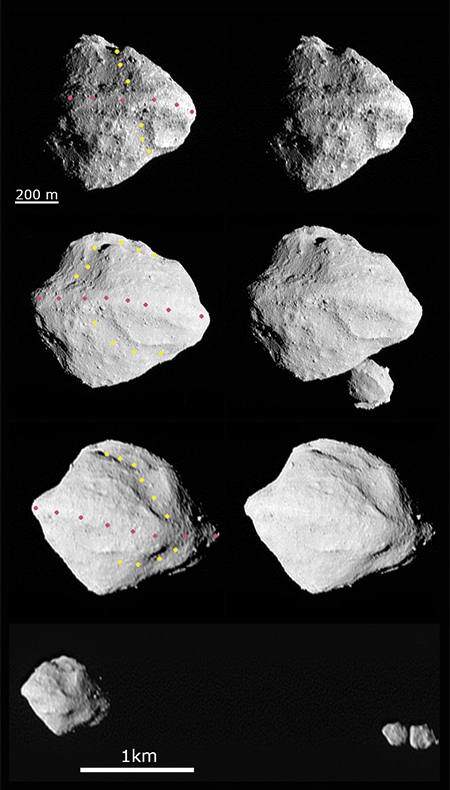
Courtesy of NASA/SwRI/Johns Hopkins APL/NOIRLAB
As NASA’s Lucy spacecraft flew past the asteroid Dinkinesh, its L’LORRI instrument produced stereographic images of the Nov. 1, 2023, encounter. The SwRI-led science team analyzed processed images, identifying a trough (yellow dots) and ridge (rose dots) on its surface. The final panel shows a side view of Dinkinesh and its satellite Selam taken a few minutes after closest approach.
Scientists think a big chunk of Dinkinesh suddenly shifted, excavating the trough and flinging debris into its vicinity. Some materials likely fell back to the asteroid body, forming the ridge, while others coalesced to form a contact binary satellite known as Selam. The complex shapes indicate that Dinkinesh and Selam have significant internal strength and a complex, dynamic history.
“To understand the history of planets like Earth, we need to understand how objects behave when they hit each other, which is affected by the strength of the planetary materials,” said SwRI’s Hal Levison, principal investigator for the Lucy mission and lead author of a paper in Nature discussing this research. “We think the planets formed as zillions of objects orbiting the Sun, like asteroids, ran into each other. Whether objects break apart when they hit or stick together has a lot to do with their strength and internal structure.”
Researchers think that Dinkinesh is revealing its internal structure in how it has responded to stress. Over millions of years, its surface was unevenly heated by the Sun. This slight imbalance caused Dinkinesh to gradually rotate faster. Stress built over time and was suddenly released as a large piece of the asteroid shifted into a more elongated shape.
“The Lucy science team started gathering data about Dinkinesh using telescopes in January 2023, when it was added to our list of targets,” said SwRI’s Simone Marchi, Lucy deputy principal investigator and the paper’s second author. “Thanks to the telescopic data, we thought we had quite a good picture of what Dinkinesh would look like, and we were thrilled to make so many unexpected discoveries.”
If the structure of Dinkinesh were weaker, more like the rubble-pile asteroid Bennu, the fragmented materials would have gradually moved toward the equator and flown off into orbit as it spun faster. However, images suggest Dinkinesh has more cohesive strength, because it could hold together longer, more like a rock that suddenly gives way under stress, fragmenting into large pieces.
“This flyby showed us Dinkinesh has some strength and allowed us to do a little ‘archeology’ to see how this tiny asteroid evolved,” Levison said. “When it broke apart, a disk of material formed, some of which rained back onto the surface, creating the ridge.”
The rest of the disk materials likely formed the double-lobed moon Selam, a contact binary. How this unusual moon ultimately formed remains a mystery, one that the scientists are already digging into.
“We see ridges around asteroids’ equators regularly among near-Earth asteroids, but seeing one up close, around an asteroid with a satellite, helps to unravel some of the possible histories of these binary asteroids,” said SwRI’s Kevin Walsh, an astrophysicist specializing in planetary formation.
SwRI-UTD Collaborative Research
Southwest Research Institute (SwRI) and the University of Texas at Dallas (UTD) have established a new program to enhance greater scientific and engineering collaboration between the two institutions. The Seed Projects for Research, INnovation, and Technology, or SPRINT, Program funds collaborative research projects, including two projects in this inaugural round.
Seeking New Domestic Sources for Lithium
Dr. Adam Cawood, of SwRI’s Earth Science Section, and Dr. Kristina Butler and Dr. Zach Sickmann, assistant professors in UTD’s Department of Sustainable Earth Systems Sciences, are leading an effort to identify new domestic lithium resources. The project aims to help address a pressing national need to reduce the reliance on imported lithium from large producers in Asia and South America.
“Global demand for lithium is expected to increase 46% by 2030, according to the U.S. Geological Survey,” Cawood said. “Right now, the U.S. only produces about 1-2% of the world’s lithium.”
To address this challenge, the project will study lithium deposit formation through fieldwork, geological mapping and subsurface interpretation in support of conceptual model development. The researchers plan to leverage their efforts to write grants seeking funding from the National Science Foundation and the U.S. Department of Energy.
“Lithium is critical to U.S. national security because we need it for battery technologies as we continue to turn toward vehicle electrification,” said Butler, who specializes in studying lithium.
Lithium exploration in the U.S. is still in its early stages, Cawood said. “We will consider established techniques from other industries and apply them to this kind of search,” he said. “As structural geologists, we look at faults and fractures in the subsurface where lithium-enriched fluids could flow, leading to lithium transport and accumulation below ground. Meeting domestic lithium demand is the ultimate goal.”
Evaluating Space Sensor in Unique Facility
A second project, led by SwRI’s Dr. Joo Hwang and UTD’s Dr. Phillip Anderson, supports a collaboration to evaluate a next-generation sensor designed to measure neutral gas velocities in the Earth’s upper atmosphere.
Geospace, the boundary region made up of the Earth’s upper atmosphere and nearby outer space, contains ionized and neutral components that are separately studied and defined as the ionosphere and thermosphere, respectively. Neutral winds largely drive the dynamics of the region, serving as the primary regulators and redistributors of the mass, momentum and energy and activating geospace weather at all latitudes.
“Understanding the dynamics of neutral wind and its coupling with ionospheric plasmas is critical for protecting military and commercial space-based assets in low Earth orbit from space weather events,” said Hwang, a staff scientist in SwRI’s Space Science Division. “We will leverage our new Molecular Beam Facility (MBF) to validate and enhance the measurement capabilities of UTD’s Neutral Wind Meter (NWM), establish development procedures, and significantly improve the signal-to-noise ratio.”
The project offers a unique opportunity to verify sensor performance and demonstrate its technical readiness level, which in turn makes the instrument more likely to be selected for upcoming missions. The integration of novel sensor technologies and molecular beam testing methodologies underscores a well-reasoned and innovative strategy to address critical gaps in understanding space weather impacts.
“A version of our instrument scheduled to fly for the first time on a rocket in 2025 will be evaluated at SwRI early next year, ” said Anderson, director of UTD’s William B. Hanson Center for Space Sciences.
SwRI has leveraged its unique expertise to establish a molecular beam accelerator at its San Antonio headquarters to meet the critical necessity for a domestic facility to verify the functionality and effectiveness of similar space sensors.

NEXTCAR II Innovations
SwRI showcased the latest developments from its ongoing NEXTCAR Phase II project at the 2024 ARPA-E Energy Innovation Summit held in Dallas. The Institute’s NEXTCAR Program aims to reduce vehicle energy consumption by more than 30% using cutting-edge connected and automated vehicle (CAV) technology.

“We are demonstrating real-world technology that highlights SwRI’s continued advancements in vehicle efficiency,” said SwRI’s Scott R. Hotz, P.E., director of SwRI’s Control Systems Department in Ann Arbor, Michigan.
In 2021, the U.S. Department of Energy awarded SwRI a three-year, $5.25 million contract through the Advanced Research Projects Agency–Energy’s (ARPA–E) NEXTCAR program. This effort builds on the success of Phase I, which won an R&D 100 Award in 2021. Phase II developed a specialized algorithm suite using connectivity and Level 4 automated driving systems. These algorithms predict traffic behavior based on data from sensors, connected vehicles, and intelligent infrastructure to optimize powertrain performance.
“These technologies show significant energy savings in simulations, and our dynamometer and real-world driving tests confirm similar improvements,” said Stas Gankov, an SwRI manager. “Our findings also highlight that while more data can improve predictions, full connectivity is not necessary for deploying these technologies, which addresses a common concern in the industry.”
SwRI’s automated driving platform, built on a production plug-in hybrid sedan, leverages widely adopted sensing technologies like lidar alongside SwRI’s patented Ranger localization system. SwRI’s drive-by-wire system provides seamless control over the accelerator, brake and electronic power steering. Algorithms like eco-driving were demonstrated in real-world tests and showcased at the Summit, while cooperative control, smart lane merging and smart lane changing continue to be refined. A subset of these technologies will be showcased at the upcoming NEXTCAR Field Day event, marking the culmination of the Phase II program.
“SwRI’s groundbreaking research has already yielded promising results,” Hotz said. “We continue to explore new research avenues and are eager to see how our NEXTCAR work progresses in the coming years.”
Targeting Urban Heat Islands in San Antonio
SwRI has created a comprehensive data analysis tool to help metropolitan areas curb urban heat islands (UHIs) and pursue mitigation methods, particularly for vulnerable populations. SwRI funded this project internally in collaboration with the City of San Antonio.
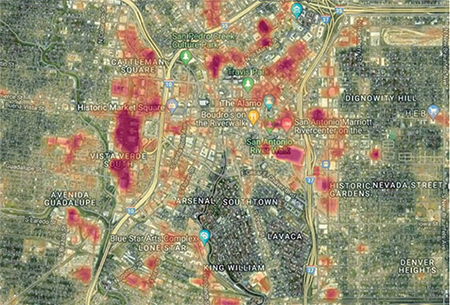
This map of San Antonio illustrates the distribution of urban heat islands (red) near downtown. SwRI created a comprehensive data analysis tool to help the city identify urban heat islands and pursue viable mitigation methods for particularly vulnerable populations.
UHIs occur when dense concentrations of pavement and buildings absorb heat and raise surrounding temperatures. Without natural or engineered heat mitigation infrastructure, UHI temperatures can exceed other areas by as much as 20°F, which could be dangerous to residents during summer.
“Tackling UHIs goes beyond simply analyzing spatial temperature differences,” said SwRI Senior Environmental Engineer Justin Long. “A comprehensive analysis of UHIs must also identify vulnerable populations, as well as viable mitigation methods in the areas where they reside.”
SwRI has created a data fusion tool that compiled and combined more than 230 datasets collected from several different city departments and public databases. The tool allows city leaders to analyze and explore several scenarios at once.
“Before the City of San Antonio can prioritize resources to address UHIs, it needs to identify all their characteristics, particularly zones here conditions are the most severe and that have a direct impact on the public,” Long said. “We discovered, for example, that many areas that experience extreme heat are also zones with historically high bus ridership. On hot summer days, pedestrians in these areas may be at higher risk of prolonged heat exposure and related illnesses.”
To demonstrate how the data fusion tool could inform UHI policy making, SwRI created a hypothetical case study, merging multiple datasets from different sources for comparison. “Mitigation strategies must be tailored to the specific characteristics of locations experiencing extreme heat from UHIs,” Long said.
The tool could show city leaders where bus stops and high surface temperatures overlap, locations where planting trees or erecting artificial structures to mitigate the heat could be most effective.
Cryptologic Systems Support for U.S. Navy
SwRI will provide engineering and equipment support for advanced cryptologic technology for shipboard and airborne platforms for the U.S. Navy. The five-year, $35.7 million contract will deliver services from June 2024 through June 2029, with the option for the Navy to add $14 million and extend the contract through 2031.
SwRI develops electronic warfare (EW) technology to detect, intercept and disrupt a range of signals on the electromagnetic spectrum, supporting efforts to thwart adversaries. As part of EW systems, cryptologic technology identifies and responds to encrypted or coded radio frequency signals.
“We develop technology critical to warfighter success,” said SwRI Senior Program Manager Robert C. Torres, who is leading this effort. “Our cryptologic equipment enhances battlespace awareness through intelligent signal surveillance of the electromagnetic environment.”
The comprehensive contract includes support services for associated equipment from installation, calibration, integration and training to lifecycle logistics support, spare parts management, maintenance, repair and technology updates.
“The Defense and Intelligence Division at SwRI has a long history of leading communications and signals intelligence programs for Department of Defense forces,” said Torres. “We continuously design and upgrade this technology, developing next-generation equipment to support U.S. armed forces and our allies.”
For more than 70 years, SwRI has developed advanced signals intelligence technology, supporting maritime, airborne and land-based operations. SwRI has deployed field-proven cryptologic equipment for use in more than 300 applications worldwide, including systems for the U.S., the Five Eyes Alliance — Australia, Canada, New Zealand, the United Kingdom and the United States — and other allied intelligence communities.

Screening for Traumatic Brain Injuries
SwRI has developed a field-ready screening tool for traumatic brain injury (TBI). The Advanced Military Measure of Olfaction (AMMO) kit includes an array of scents, deployable anywhere from the battlefield to the football field, to help screen for TBIs in minutes.
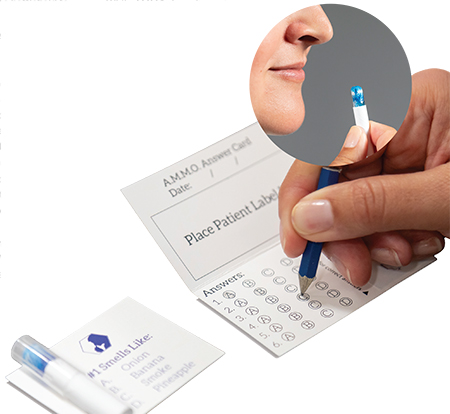
“The AMMO test kit is not intended as a diagnostic test but as a screening tool,” said SwRI Senior Research Engineer Kreg Zimmern, the project’s leader.
The kit includes six sealed vials that release a range of odors, such as fruity and spicy aromas. When squeezed, a test vial turns blue to indicate a smell has been released and is ready for use. Patients identify the odor from four possible choices on an attached card; The correct answers are hidden behind a sticker. Research shows failing to identify the scents correctly correlates highly with positive results for TBI on an MRI exam.
“Someone exposed to a blast on the battlefield could be screened immediately with AMMO instead of waiting for the onset of signs or symptoms of TBI. The inability to identify the scents could be used as rationale to justify an MRI,” Zimmern said.
AMMO is undergoing stability studies to determine how long the kit can be stored and still be effective. SwRI is developing AMMO in compliance with relevant FDA and ISO guidelines. It’s the only olfactory test kit to undergo such rigorous controls.
“The kit is inexpensive, compact, has no special storage conditions and doesn’t need electricity,” Zimmern said. “This makes it a potential screening tool in emergency rooms as well as at workplaces, nursing homes and youth, collegiate and professional sports games.”
While AMMO doesn’t require any specialized training to administer, the results can inform the decision-making process for first responders and doctors.
STEP Demo Generates Electricity for the First Time
The Supercritical Transformational Electric Power (STEP) Demo pilot plant has generated electricity for the first time using supercritical carbon dioxide (sCO2) power cycles. The $169 million, 10-megawatt sCO2 facility at SwRI in San Antonio is demonstrating next-generation power production technology in a project led by GTI Energy in collaboration with SwRI, GE Vernova, the U.S. Department of Energy/National Energy Technology Laboratory, and several industry participants.
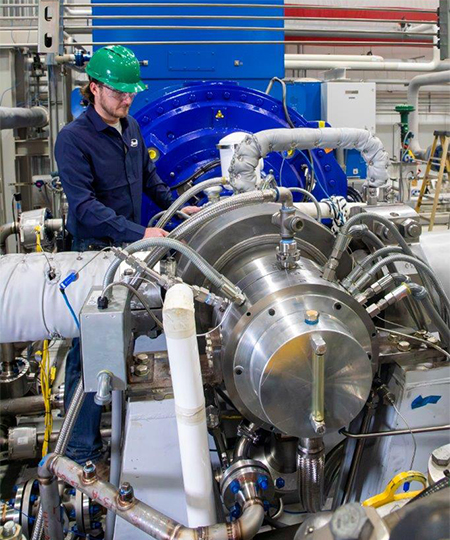
The Supercritical Transformational Electric Power (STEP) Demo pilot plant at SwRI generated electricity for the first time. The pilot plant’s turbine achieved its full speed of 27,000 RPM, an operating temperature of 260 °C and generated a small amount of power.
“The impact of demonstrating that the sCO2 technology works cannot be overstated,” said SwRI Project Manager Dr. Jeff Moore. “I truly believe this project will change how we approach power generation in the near future.”
For the first time, the pilot plant’s turbine achieved its full speed of 27,000 RPM at an operating temperature of 260°C, while generating a small amount of power. Over the next few weeks, the STEP team will slowly ramp up the operating temperature to 500°C and generate 5 megawatts (Mwe) of power, enough to power 5,000 homes.
Following this test configuration, the STEP Demo project will enter its final phase. The pilot plant will be reconfigured to boost the power plant’s efficiency and overall energy output. This modification requires the installation of new equipment, as well as a new commission and test phase that will continue into 2025 until the pilot plant is running at full power. At the end of its final phase, the pilot plant will produce 10 MWe hourly, enough to power 10,000 homes.
The STEP Demo pilot plant is one of the largest demonstration facilities in the world for sCO2 technology. Unlike conventional steam power plants, which use water as the thermal medium, STEP uses high-temperature sCO2 to increase efficiency by as much as 10% due to its favorable thermodynamic properties.
Evidence of Hydration on Psyche
Using data from NASA’s James Webb Space Telescope, an SwRI-led team has confirmed hydroxyl molecules on the surface of the metallic asteroid Psyche. The presence of hydrated minerals suggests a complex history for Psyche, important context for the NASA spacecraft en route to this interesting asteroid orbiting the Sun between Mars and Jupiter.
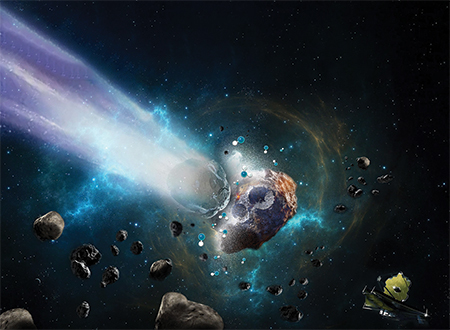
Using NASA’s Webb telescope, shown in the bottom right corner of this illustration, an SwRI-led team confirmed the presence of hydrated minerals on the surface of Psyche, a massive and heavily metallic body in the main asteroid belt.
At about 140 miles in diameter, Psyche is one of the most massive objects in the main asteroid belt. Previous observations indicate that Psyche is a dense, largely metallic object that could be a leftover core from a planet that experienced a catastrophic collision. On Oct. 13, 2023, NASA launched the Psyche spacecraft, which is traveling 2.2 billion miles to arrive at the asteroid in August 2029.
“Using telescopes at different wavelengths of infrared light, the SwRI-led research will provide different but complementary information to what the Psyche spacecraft is designed to study,” said SwRI’s Dr. Tracy Becker, second author of a new American Astronomical Society’s Planetary Science Journal paper discussing these findings.
The Webb data point to hydroxyl and perhaps water on Psyche’s surface. The hydrated minerals could result from external sources, including impactors. If the hydration is native or endogenous, then Psyche may have a different evolutionary history than current models suggest.
“Asteroids are leftovers from the planetary formation process, so their compositions vary depending on where they formed in the solar nebula,” said SwRI’s Dr. Anicia Arredondo, another co-author.
Understanding the location of asteroids and their compositions tells us how materials in the solar nebula were distributed and have evolved since formation. How water is distributed in our solar system will provide insight into the distribution of water in other solar systems and, because water is necessary for all life on Earth, will drive where to look for potential life, both in our solar system and beyond.
Bolstering Earthquake Readiness
SwRI is enhancing models to strengthen the earthquake resilience of America’s transportation infrastructure and improve public safety in earthquake-prone areas. As part of a contract with the U.S. Federal Highway Administration (FHWA), an SwRI-led team is updating and improving liquefaction models. Liquefaction occurs during an earthquake when intense shaking causes soil to temporarily act more like a fluid, losing its capacity to support roads and structures.
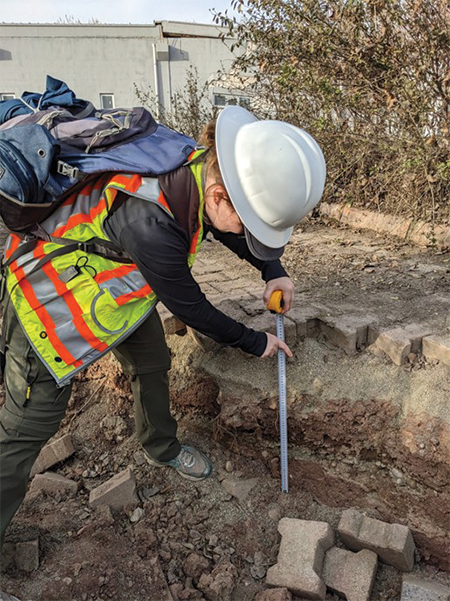
Dr. Kristin Ulmer assesses damage from a massive earthquake in Turkey in 2023. Ulmer leads a team improving models to help the Federal Highway Administration identify mitigation efforts needed to shore up America’s roads, bridges and tunnels.
“For highways specifically, sometimes state and local authorities don’t have the luxury of choosing a different location to build to avoid areas that are potentially vulnerable to liquefaction,” said SwRI Senior Research Engineer Dr. Kristin Ulmer, the principal investigator of the project.
Over the next five years, the team will expand upon past work performed for the Next Generation Liquefaction (NGL) project. The NGL project is a community-driven collaboration with an open-source database of earthquake and liquefaction case histories from around the world.
“We will build on past NGL work to develop predictive models to better understand where liquefaction is most likely to occur and determine its impacts,” said Ulmer.
Liquefaction is a dangerous phenomenon that can cause catastrophic loss of life and disruptions to supply chains. To better identify at-risk areas and infrastructure, updated predictive models will identify if costly mitigation strategies are needed to prevent serious damage in an earthquake.
“That’s the goal — improving public safety and providing the most useful and up-to-date tools to evaluate earthquake-related hazards to America’s roads, bridges and tunnels,” said Ulmer.
The SwRI team will collaborate with researchers from The University of California, Los Angeles and Oregon State University on this project. The project is sponsored by Structures and Geotechnical Programs of the FHWA Office of Bridges and Structures.
SwRI Launches Battery Consortium
SwRI launched the second phase of a consortium dedicated to understanding the performance of energy storage systems. The Electrified Vehicle and Energy Storage Evaluation-II (EVESE-II) consortium builds on more than a decade of SwRI-led, precompetitive research with companies across the mobility sector.
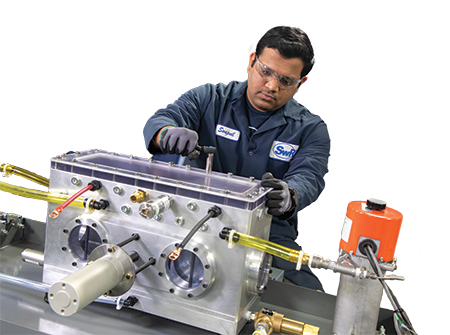
SwRI Research Engineer Dr. Swapnil Salvi demonstrates a battery immersion cooling test rig used to support the Electrified Vehicle and Energy Storage Evaluation-II (EVESE-II) consortium.
“We are proud to serve the EV industry by bringing together manufacturers, suppliers and battery designers and developers with materials scientists to address a variety of challenges,” said Dr. Andre Swarts, an SwRI staff engineer in SwRI’s Automotive Propulsion Systems Department.
EVESE-II will continue battery cell research while expanding its focus on module and pack research. “Cell research will remain at the heart of the program with a focus on test repeatability, cell aging and fast-charging behavior as well as exploring emerging cell chemistries with increased energy capacities,” Swarts said.
Performance and abuse testing at various scales will provide critical data and insights to improve thermal management and safety performance using different technologies. For instance, direct cooling immerses the battery cells or packs into a dielectric fluid that dissipates heat more effectively than air cooling.
“The emphasis on immersion cooling came out of past EVESE work, which underscored its ability to enhance thermal management and mitigate thermal runaway,” said SwRI collaborator Dr. Swapnil Salvi. “SwRI has developed a substantial portfolio of test capabilities over the past few years to support these research activities.”
In addition, EVESE-II will explore new charging technologies, vehicle-to-everything (V2X) systems and advanced in-situ battery health diagnostics, all supported by advanced modeling and simulation.
Cybersecurity Risks with EV Fast-Charging Equipment
SwRI engineers have identified cybersecurity vulnerabilities with electric vehicles (EVs) using direct current fast-charging systems, the quickest way to charge electric vehicles. The high-power technology relies on power line communication (PLC) technology to transmit smart-grid data between vehicles and charging equipment.
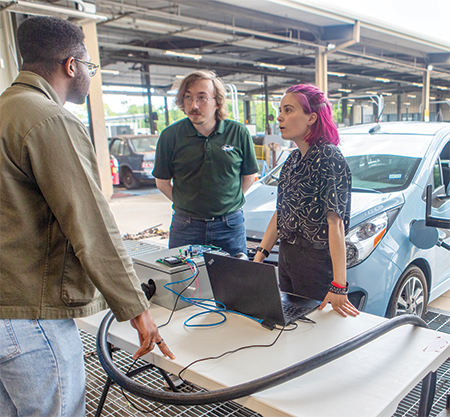
SwRI research engineers, from left, FJ Olugbodi, Mark Johnson and Katherine Kozan demonstrate an adversary-in-the-middle device developed to test the cyber resiliency of ISO 15118-compliant vehicle-to-grid charging systems. With the device, SwRI identified cybersecurity vulnerabilities with electric vehicles using direct current fast-charging systems.
A laboratory setup exploited vulnerabilities in the PLC, gaining access to network keys and digital addresses on both the charger and the vehicle.
“Penetration testing found that the PLC was poorly secured and lacked encryption between the vehicle and the chargers,” said Katherine Kozan, who led the project for SwRI’s High Reliability Systems Department. Older chips exhibited unsecure key generation when tested, which was confirmed to be a known concern.
The research is part of SwRI’s ongoing efforts to help the mobility sector and government improve automotive cybersecurity spanning embedded automotive computers and smart-grid infrastructure. It builds upon a 2020 project where SwRI hacked a J1772 charger, disrupting the charging process with a lab-built spoofing device.
In the latest project, SwRI explored vehicle-to-grid (V2G) charging technologies governed by ISO 15118 specifications for communications between EVs and electric vehicle supply equipment to support electric power transfer.
“As the grid evolves to take on more EVs, we need to defend our critical grid infrastructure against cyberattacks while also securing payments to charge EVs,” said Vic Murray, assistant director of SwRI’s High Reliability Systems Department. “Our research found room for improvements.”
“Adding encryption to the network membership key would be an important step in securing the V2G charging process,” said FJ Olugbodi, who contributed to the project. “With network access granted by unsecure direct access keys, the nonvolatile memory regions on PLC-enabled devices could be easily retrieved and reprogrammed.”
New Hypersonic Engine Research Facility Underway
SwRI recently broke ground for the Center for Accelerating Materials and Processes (CAMP), a new facility that will support research and development for tomorrow’s high-speed aerospace engines.
“This project will help ensure the U.S. is a leader in high-speed propulsion research and development,” said Dr. Barron Bichon, director of SwRI’s Materials Engineering Department. “SwRI is committed to advancing this vital technology on behalf of Texas and the nation.”
Market forces including growth in global defense, air travel, delivery and transportation needs are driving the demand for high-speed engines. Initial projects in the new CAMP facility will focus on demonstrating faster, more efficient techniques for manufacturing high-speed propulsion systems.
Once construction on the new two-story, 33,500-square-foot facility is complete, SwRI will begin evaluating new materials and processes designed to produce a high-speed engine in a considerably shorter amount of time than current production timelines.
“This new facility will see the development of innovative technology that reflects SwRI’s mission of serving humankind,” said Dr. Ben Thacker, vice president of SwRI’s Mechanical Engineering Division. “Advancing high-speed propulsion systems propels us toward a future with stronger defense capabilities and greater global connectivity.”
One of the CAMP facility’s initial projects will involve procuring and installing manufacturing process test equipment. Under a contract from the Office of the Secretary of Defense’s Manufacturing Science and Technology Program, SwRI engineers will demonstrate how the facility will reduce production times and costs. The Institute will invest an estimated $34 million in the construction of the CAMP facility.
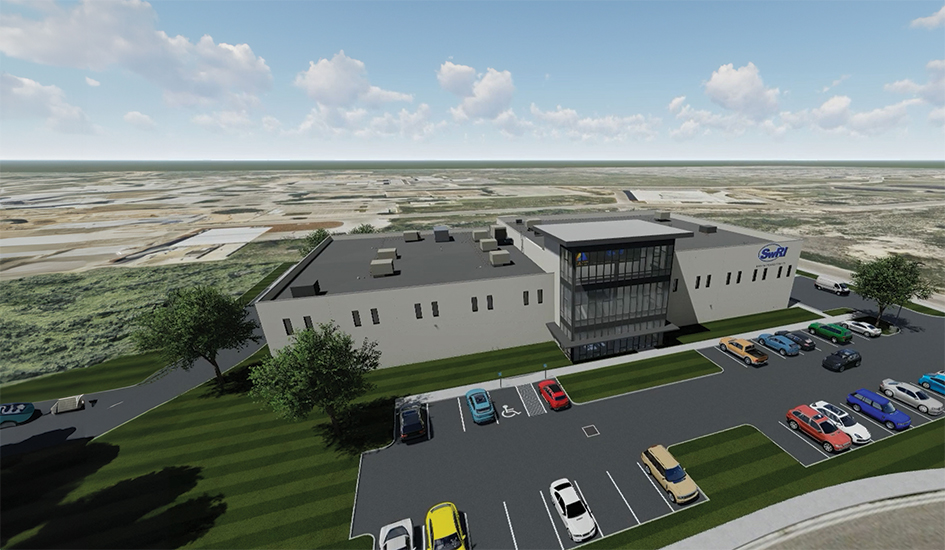
Screening for Novel DNA-Targeting Therapeutics
SwRI has developed a unique technology to screen new DNA-targeting therapeutics designed to treat cancer and other diseases. Combining SwRI’s 3D drug screening software tool Rhodium™ and machine learning techniques, SwRI scientists successfully predicted the DNA binding affinity and cancer cell toxicity for a variety of relevant drug compounds under development. This enables SwRI scientists to visualize and rapidly predict how DNA-targeting therapeutics can attack cancer cells as well as other diseases.

SwRI’s Rhodium™ software can now screen potential DNA-targeting therapeutics for cancer and other diseases. This image was made using the PyMOL Molecular Graphics System (Version 3.0 Schrödinger LLC).
According to the World Health Organization, cancer is a leading cause of death worldwide, responsible for one in six deaths globally. Many chemotherapy drugs directly target DNA to shrink tumors and slow or stop the growth and spread of cancer cells. However, this approach can also damage the DNA in healthy cells, leading to severe side effects, medical complications and even secondary cancers. While many drug development platforms and machine learning methods focus on virtually screening drugs that target proteins, few methods exist for screening drugs that target DNA. SwRI has now successfully demonstrated a virtual screening application to design more effective DNA-targeting therapeutics to combat different types of cancer and infectious diseases.
“Cancer cells often have damaged DNA repair machinery and replicate much faster than healthy cells, which makes DNA a viable target for selective cancer treatment,” said Dr. Tristan Adamson, a research scientist in SwRI’s Pharmaceutical and Bioengineering Department. “SwRI has successfully developed and validated a powerful technique to use Rhodium for drug development campaigns that directly target DNA in oncology research for leukemia, breast cancer, liver cancer and more.”
Dillon Cao, an SwRI scientist working with Adamson, added, “We want to make drug compounds more selective to target a patient’s DNA for maximum efficacy while at the same time enabling scientists to prune away some of the drug toxicities.”
As part of an internally funded research project, SwRI scientists developed several machine learning training sets, each serving important roles in screening potential DNA-targeting oncology drugs. These models have been validated using statistical tests and correlated with published experimental data. SwRI scientists accurately predicted the effectiveness of drug compounds against several cancer cell models using the technique. They now plan to apply this software in future drug development programs to design next-generation cancer therapeutics.
SwRI used internal funding to develop Rhodium software to provide a computer-aided tool to rapidly screen possible treatment methods to combat infectious diseases and chemical/biological warfare agents. SwRI’s machine learning capabilities can evaluate more than 2 million drug compounds in just a few days to identify compounds with high probability for successful treatment with minimal adverse side effects. SwRI has used Rhodium to successfully identify highly potent therapeutics for several infectious diseases, such as COVID-19 and hemorrhagic fevers, as well as chemical nerve agent antidotes.
SwRI has more than 75 years of pharmaceutical research and development experience including virtual drug design, medicinal chemistry, formulation, microencapsulation, process development and CGMP synthesis scale-up.

